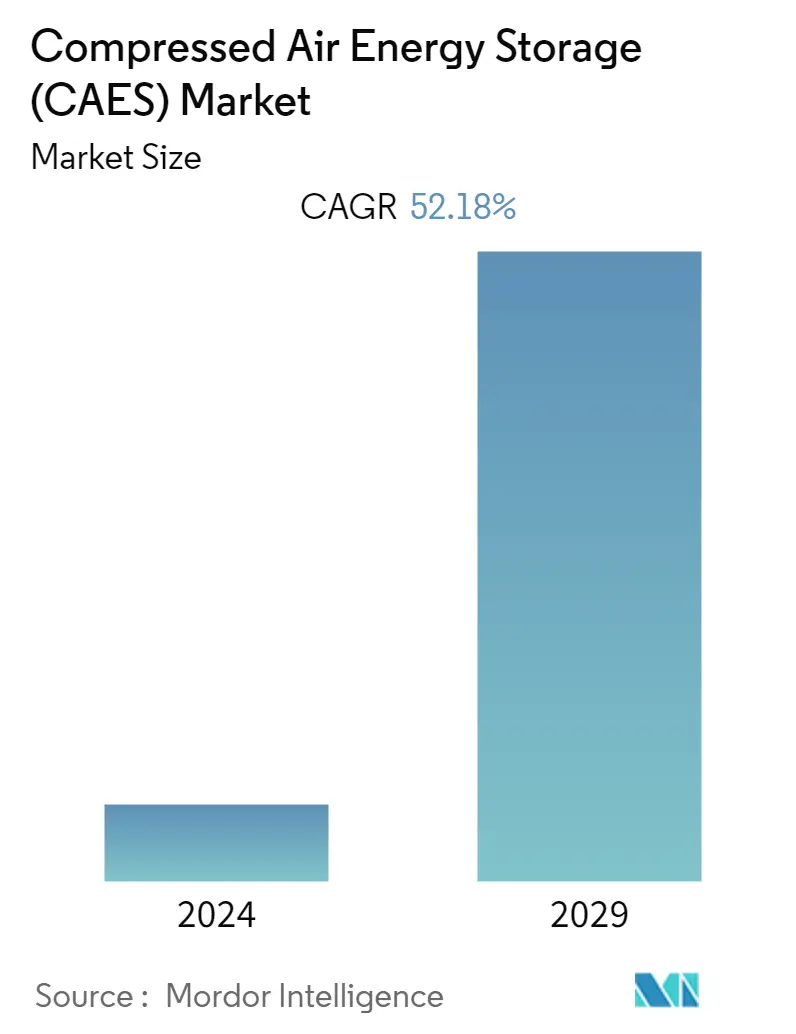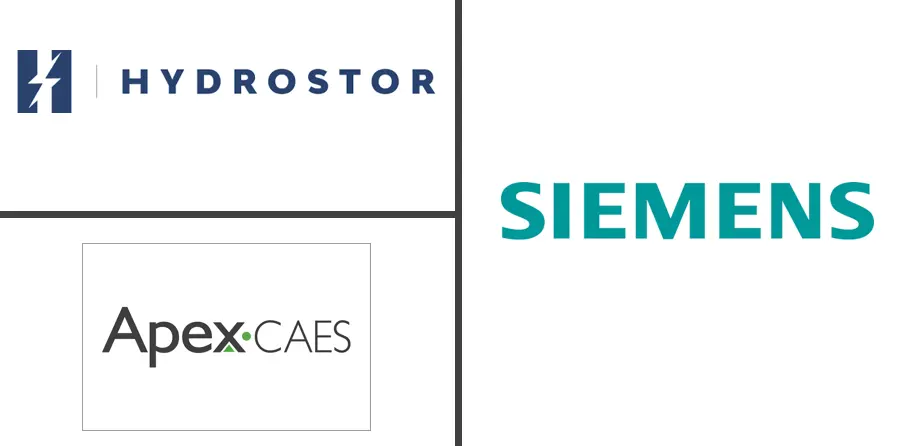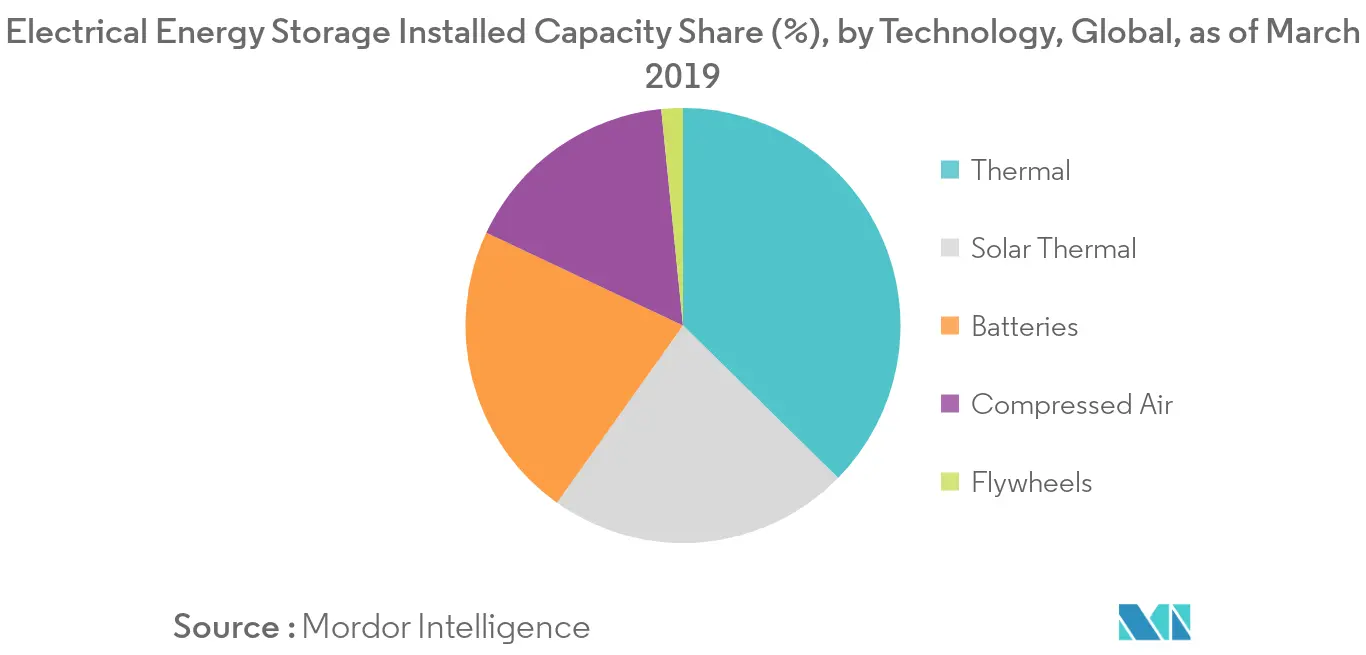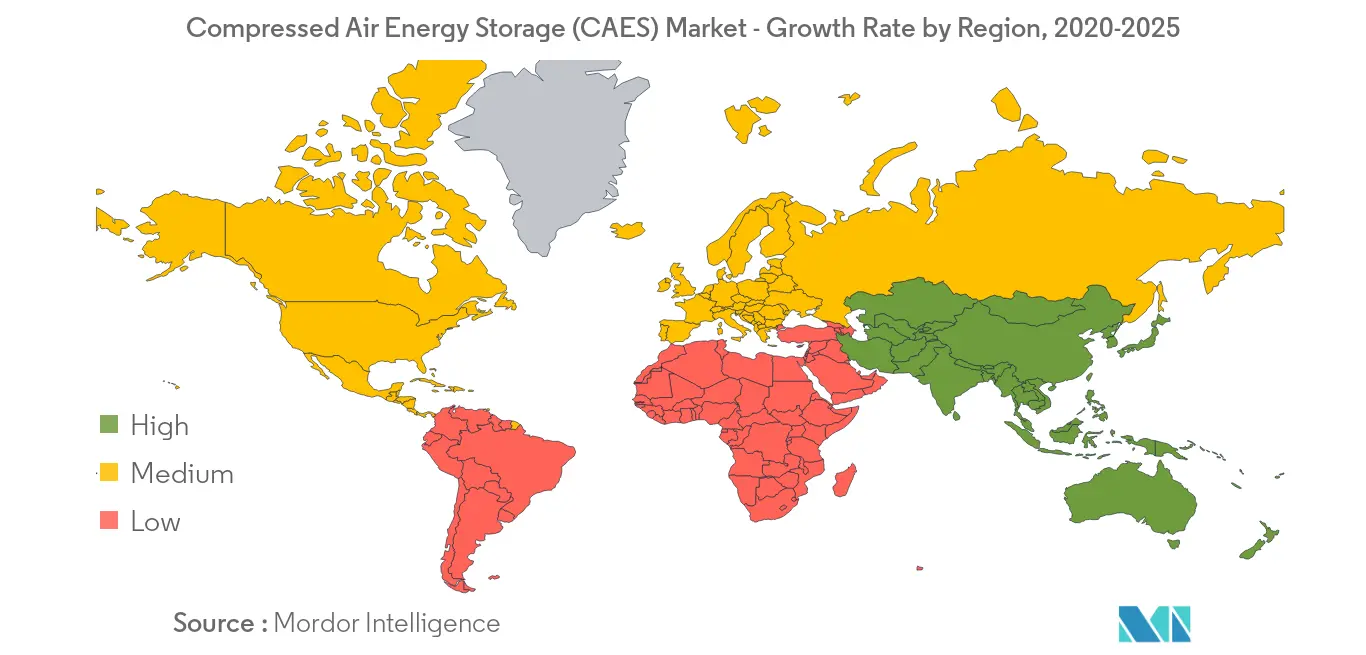Compressed Air Energy Storage (CAES) Market Size

| Study Period | 2020 - 2029 |
| Base Year For Estimation | 2023 |
| CAGR | 52.18 % |
| Fastest Growing Market | Asia Pacific |
| Largest Market | Europe |
| Market Concentration | High |
Major Players
*Disclaimer: Major Players sorted in no particular order |
Compressed Air Energy Storage (CAES) Market Analysis
The compressed air energy storage market is expected to grow at a CAGR of more than 42% over the forecast period of 2020-2025. Factors such as renewable integration with compressed air energy storage systems and implementation of demonstration projects, coupled with technological developments in the compressed air energy storage systems, are expected to drive the market studied during the forecast period. However, the market for compressed air energy storage systems remained underdeveloped, due to several reasons, such as lack of investment and lack of technology, which prevented the development of new compressed air energy storage plants.
- As of 2019, the diabatic compressed air energy storage systems were the only type of systems that had been deployed for commercial purposes. The first diabatic compressed air energy storage plant, Huntorf compressed air energy storage plant, was built in Germany in 1978. This compressed air energy storage plant had a capacity of 298 MW and efficiency of only around 40%. The adiabatic and isothermal compressed energy storage systems are currently in the research phase.
- The use of compressed air energy storage in the offshore wind turbines is likely to increase as this technology is less expensive and environment friendly, creating new avenues for the compressed air energy storage players in the near future.
- At a regional level, large-scale renewable energy deployment, coupled with rising demand for large scale energy storage system, is driving the market studied in North America, which is expected to be the fastest market in terms of number of CAES projects.
Compressed Air Energy Storage (CAES) Market Trends
This section covers the major market trends shaping the Compressed Air Energy Storage Market according to our research experts:
Diabatic CAES Technology to Dominate the Market
- The diabatic compressed air energy storage plants are a conventional type of systems, where, during the compression process the excessive heat generated is released to the atmosphere. During power generation, the required heat is generated generally using the natural gas.
- As a result, the diabatic compressed air energy storage systems, though simple and relatively less costly, have lower efficiency, and are less environment-friendly than other types of compressed air energy storage systems. The diabatic compressed air energy storage systems achieve an efficiency of around 50%, significantly lower than the other upcoming technologies.
- In 2018, the diabatic compressed air energy storage systems are the only type of systems that have been deployed for commercial purpose. The first diabatic compressed air energy storage plant, Huntorf compressed air energy storage plant, was built in Germany, in 1978. This compressed air energy storage plant has the capacity of 298 MW and efficiency of only around 40%. The second plant was built in Alabama, United States, in 1991, with a capacity of 110 MW and efficiency of above 50%. The adiabatic systems achieve efficiency about 20% more than the diabatic systems.
- The operating cost of the diabatic compressed air energy storage plants is significantly lower than the adiabatic and isothermal compressed air energy storage plants. As a result, the diabatic plants are generally more profitable to operate. However, as the plants require gas-firing for operation, the diabatic plants are less ecological. As the concerns regarding the climate change are rising globally, the other compressed air energy storage plants are being preferred over the diabatic plants.
- With the development in other technology, the share of diabatic compressed air energy storage systems in the market is expected to decline during the forecast period. Among the announced compressed air energy storage projects worldwide, none of the major projects use diabatic technology. A similar trend is expected to continue during the forecast period, which, in turn, is expected to restrain the market growth of the diabatic compressed air energy storage systems market.

North America to Dominate the Market, in Terms of Number of CAES Projects
- The United States power sector is in the midst of profound transformation with the fast-paced replacement of coal-based electricity generation with natural gas. Owing to decreasing costs and vast environmental benefits offered, renewables integration has also picked up at a very rapid pace.
- In a bid to ensure the stability of the aging power grid of the country, large-scale implementation of energy storage systems is being considered critical. Moreover, with the country trying to decarbonize the economy, considering the environment, the share of renewable for power generation is expected to increase. With the increase in the country's reliance on renewables for energy demand, an uninterrupted supply of power is necessary and owing to renewables being heavily reliant on prevailing weather conditions, a need for efficient energy storage is expected to increase, during the forecast period.
- With compressed air energy storage solution providing a viable technology for use, the market is expected to grow once the countries start to recover from the recent COVID-19 pandemic. In the United States, as of June 2018, there were 3 operating CAES systems, with a combined rated power of 113.5 MW.
- However, certain projects, such as Iowa Stored Energy Park (ISEP) project, Iberdrola United States, Norton Ohio CAES, and LightSail company I-CAES were seized before commercialization.
- The seizure of certain projects clubbed with the recent pandemic, which has resulted in the highest number of cases in the United States, has a potential to inflict the growth momentum of the market. With vaccines not expected to be developed before the start of 2021, the pandemic is likely to halt the economic activities which may decrease the power demand and thereby the need for CAES projects for energy storage.
- With the low demand of CAES project, the new investments are likely to be halted and ongoing projects are expected to be delayed, thereby restraining the growth of the market during the next two year.

Compressed Air Energy Storage (CAES) Industry Overview
The compreesed air energy storage market is consolidated. Some of the key players operating in the market studied are Siemens, Hydrostor, Apex CAES, and Ridge Energy Storage and Grid Services. Overall, the market studied is assessed to be consolidated, less competitive, capital intensive, and non-lucrative in nature.
Compressed Air Energy Storage (CAES) Market Leaders
-
Siemens AG
-
Hydrostor Inc.
-
Apex CAES LLC
*Disclaimer: Major Players sorted in no particular order
 Market - Market Concentration.png)
Compressed Air Energy Storage (CAES) Market Report - Table of Contents
1. INTRODUCTION
- 1.1 Scope of Study
- 1.2 Market Definition
- 1.3 Study Assumptions
2. RESEARCH METHODOLOGY
3. EXECUTIVE SUMMARY
4. MARKET OVERVIEW
- 4.1 Introduction
- 4.2 Global CAES Capacity (in MW) and Future Potential
- 4.3 Recent Trends and Developments
- 4.4 Government Policies and Regulations
-
4.5 Market Dynamics
- 4.5.1 Drivers
- 4.5.2 Restraints
-
4.6 Porter's Five Forces Analysis
- 4.6.1 Bargaining Power of Suppliers
- 4.6.2 Bargaining Power of Consumers
- 4.6.3 Threat of New Entrants
- 4.6.4 Threat of Substitute Products and Services
- 4.6.5 Intensity of Competitive Rivalry
5. MARKET SEGMENTATION
-
5.1 Type
- 5.1.1 Adiabatic
- 5.1.2 Diabatic
- 5.1.3 Isothermal
-
5.2 Geography
- 5.2.1 North America
- 5.2.2 Europe
- 5.2.3 Asia-Pacific
- 5.2.4 Rest of the World
6. COMPETITIVE LANDSCAPE
- 6.1 Mergers & Acquisitions, Joint Ventures, Collaborations, and Agreements
- 6.2 Strategies Adopted by Leading Players
-
6.3 Company Profiles
- 6.3.1 Siemens AG
- 6.3.2 Hydrostor Inc.
- 6.3.3 Apex Compressed Air Energy Storage LLC
- 6.3.4 Ridge Energy Storage and Grid Services LP
- *List Not Exhaustive
7. MARKET OPPORTUNITIES AND FUTURE TRENDS
** Subject To AvailablityCompressed Air Energy Storage (CAES) Industry Segmentation
The compressed air energy storage (CAES) market report include:
| Type | Adiabatic |
| Diabatic | |
| Isothermal | |
| Geography | North America |
| Europe | |
| Asia-Pacific | |
| Rest of the World |
Compressed Air Energy Storage (CAES) Market Research FAQs
What is the current Compressed Air Energy Storage (CAES) Market size?
The Compressed Air Energy Storage (CAES) Market is projected to register a CAGR of 52.18% during the forecast period (2024-2029)
Who are the key players in Compressed Air Energy Storage (CAES) Market?
Siemens AG, Hydrostor Inc. and Apex CAES LLC are the major companies operating in the Compressed Air Energy Storage (CAES) Market.
Which is the fastest growing region in Compressed Air Energy Storage (CAES) Market?
Asia Pacific is estimated to grow at the highest CAGR over the forecast period (2024-2029).
Which region has the biggest share in Compressed Air Energy Storage (CAES) Market?
In 2024, the Europe accounts for the largest market share in Compressed Air Energy Storage (CAES) Market.
What years does this Compressed Air Energy Storage (CAES) Market cover?
The report covers the Compressed Air Energy Storage (CAES) Market historical market size for years: 2020, 2021, 2022 and 2023. The report also forecasts the Compressed Air Energy Storage (CAES) Market size for years: 2024, 2025, 2026, 2027, 2028 and 2029.
Compressed Air Energy Storage (CAES) Industry Report
Statistics for the 2024 Compressed Air Energy Storage (CAES) market share, size and revenue growth rate, created by Mordor Intelligence™ Industry Reports. Compressed Air Energy Storage (CAES) analysis includes a market forecast outlook to 2029 and historical overview. Get a sample of this industry analysis as a free report PDF download.



